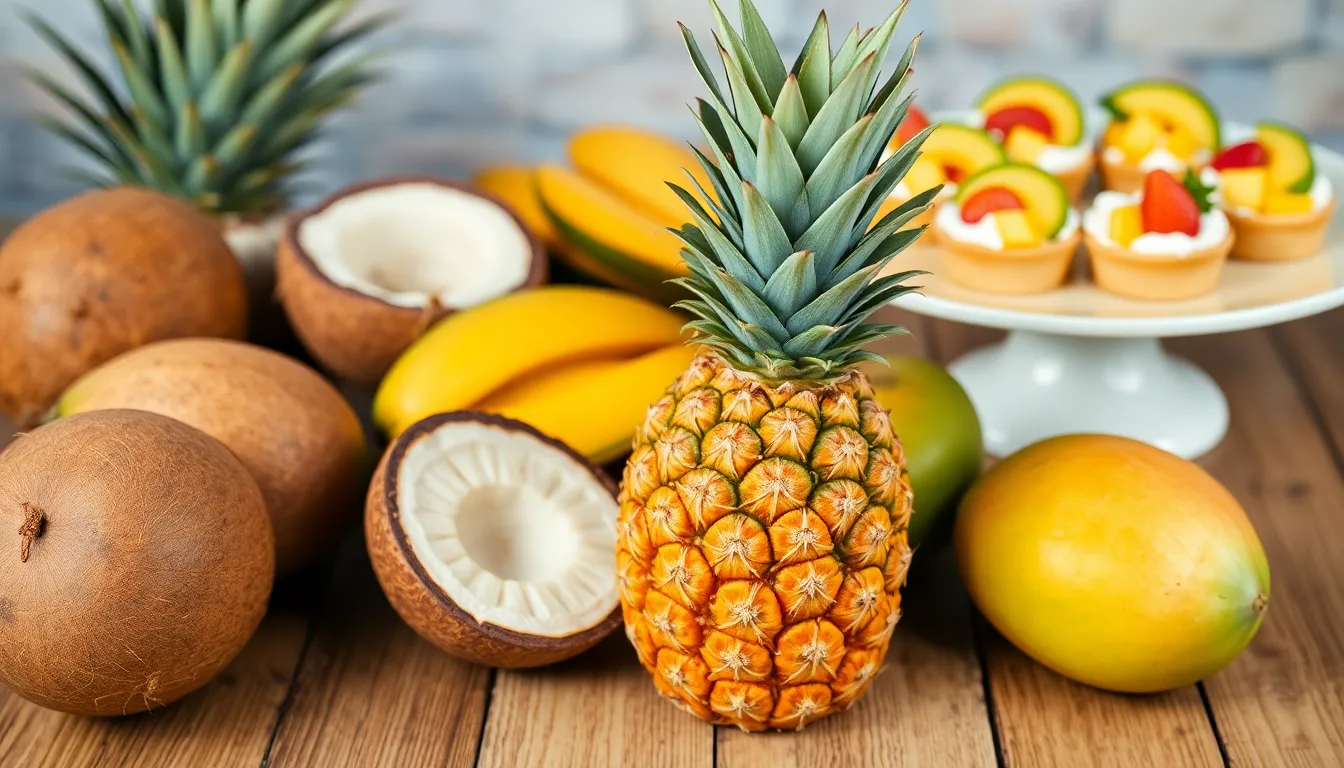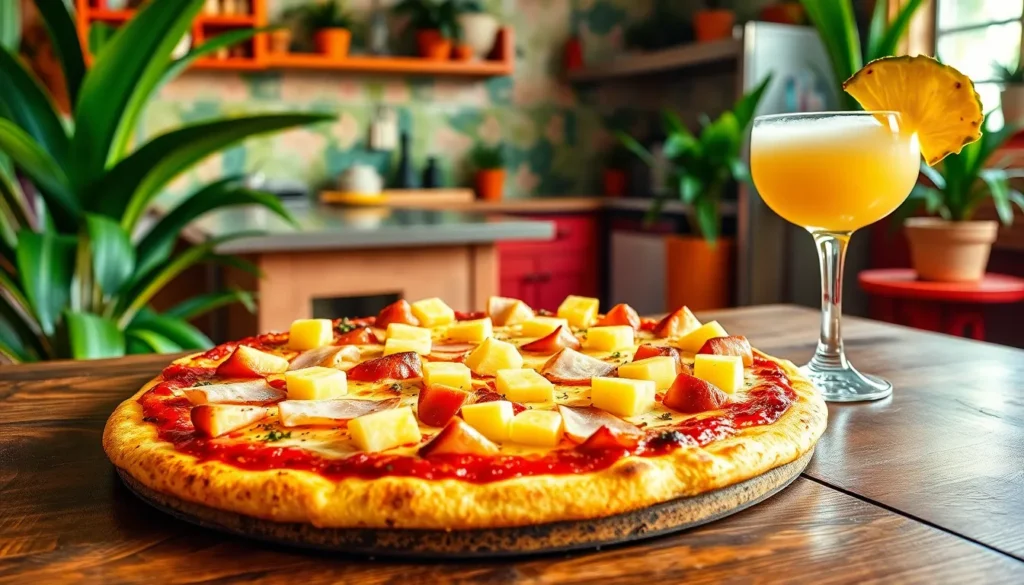Picture this: a sunny beach, a cool breeze, and the tantalizing aroma of a pizza fresh out of the oven. But wait—what’s that tropical twist? Pineapple! Love it or hate it, this juicy fruit has sparked fierce debates among food lovers. Does it really elevate the flavor game, or is it just a sweet distraction?
In the culinary world, pineapple’s role is nothing short of controversial. Some swear by its ability to enhance savory dishes, while others see it as a culinary crime. So, what’s the verdict? Is pineapple the secret ingredient that takes your taste buds on a joyride, or does it simply crash the party? Let’s dive into the juicy details and uncover whether this tropical treat truly makes everything better.
Table of Contents
ToggleUnderstanding Pineapple’s Flavor Profile
Pineapple brings a distinctive flavor to various dishes, proving whether it enhances flavors or not. Analyzing its components reveals why some find its inclusion delightful.
Natural Sweetness
Natural sweetness characterizes pineapple, contributing to its versatility in both sweet and savory cuisines. This sweetness creates a pleasant contrast against salty or savory ingredients. Dishes like ham, seafood tacos, and tropical salads benefit from pineapple’s sugary notes. In baking, it enhances desserts, such as upside-down cakes and tarts, providing depth. The sugars in pineapple stimulate taste buds, enhancing overall flavor perception.
Unique Acidity
Unique acidity defines pineapple’s flavor, striking a balance that complements rich, fatty dishes. The fruit contains citric and malic acids, which cut through heavier flavors. This quality is especially noticeable on pizza, where a burst of acidity brightens the dish. The acidity also evokes freshness, making it a popular choice in salsas and marinades. Food experiences become more dynamic with pineapple, appealing to those seeking vibrant flavor profiles.
Culinary Uses of Pineapple

Pineapple features prominently in various culinary applications, enhancing both sweet and savory dishes.
In Sweet Dishes
Pineapple shines in desserts. Its natural sweetness complements recipes like upside-down cakes and fruit salads. Pineapple pairs well with coconut in tropical treats such as tarts and sorbets. The fruit also adds a zesty touch to smoothies, enriching flavors and textures. Additionally, pineapple’s acidity balances sweetness, making it ideal for fruit salsas topped on desserts. This versatility expands dessert opportunities, appealing to varied taste preferences.
In Savory Dishes
Pineapple transforms savory meals. It enriches pizzas, harmonizing with cheese and meats. The fruit adds brightness to grilled seafood dishes and tacos, creating delightful contrasts. Pineapple also enhances stir-fries and curries, contributing a unique balance to rich sauces. Furthermore, it plays a crucial role in marinades, tenderizing proteins and infusing them with a tropical flavor. This adaptability establishes pineapple as a favorite ingredient in diverse culinary contexts.
The Science Behind Flavor Enhancement
Pineapple’s role in enhancing flavors extends beyond personal preference. Scientific concepts like flavor pairing and chemical interactions reveal its effectiveness in culinary applications.
Flavor Pairing Theory
Flavor pairing theory suggests that ingredients with similar flavor compounds enhance each other’s taste. Pineapple pairs well with foods containing umami, such as pork and shrimp. Chefs often use pineapple to elevate savory dishes, as the sweet acidity balances rich flavors. Additionally, its compatibility with herbs and spices, like cilantro and chili, creates vibrant and balanced culinary experiences. Experimenting with pineapple in various combinations can lead to unexpected and delightful taste profiles.
Chemical Compounds in Pineapple
Pineapple contains bromelain, a digestive enzyme that tenderizes meat and enhances flavor absorption. Its unique acidity comes from citric and malic acids, which brighten dishes. Further, the presence of natural sugars contributes to its sweetness, complementing savory elements. These chemical compounds not only impact taste but also influence texture, making pineapple a valuable ingredient in both marinades and salsas. Understanding these components clarifies why pineapple effectively enhances the overall flavor of a dish.
Popular Combinations and Pairings
Pineapple complements various dishes, enhancing overall flavor profiles. Its versatility makes it a popular ingredient in both savory and sweet culinary applications.
Pineapple on Pizza
Pineapple’s presence on pizza sparks passionate discussions among pizza enthusiasts. While some embrace its sweetness, others view it as a culinary faux pas. Those who appreciate pineapple on pizza often cite the delightful contrast between its sweetness and the savory aspects of cheese and ham. Ingredients like mozzarella, ham, and basil often harmonize well with pineapple, creating a balanced flavor experience. Research shows that the combination appeals strongly to those who enjoy sweet and savory pairings.
Pineapple in Cocktails
In cocktails, pineapple serves as a refreshing addition that brightens flavors. Tiki drinks often feature pineapple juice, complementing rum and coconut for a tropical experience. Common combinations include piña coladas and mai tais. The natural sweetness of pineapple pairs exceptionally well with sour elements, such as lime juice. These mixes create a well-rounded and enjoyable beverage, making pineapple a staple in many bartenders’ recipes. Its acidity balances alcohol and adds a tropical flair, appealing to those seeking vibrant and refreshing drinks.
Personal Experiences and Testimonials
Opinions on pineapple’s culinary role often emerge in various dining experiences and home kitchens. Personal stories illustrate its impact on food.
Restaurant Feedback
Diners frequently share delight in the surprising harmony created by pineapple on pizza. Some guests savor the contrast of sweet fruit against rich cheese and savory meats. Feedback from restaurant patrons consistently highlights this combination, leading chefs to feature pineapple-topped dishes prominently on menus. Others appreciate pineapple’s refreshing brightness in salsas served alongside grilled meats. Many also share enthusiasm for tropical-themed cocktails because pineapple adds a lively sweetness that balances acidity. Overall, restaurant experiences reveal the diverse enjoyment of pineapple’s flavor-enhancing capabilities.
Home Cooking Insights
Home cooks often experiment with pineapple in various recipes. They find that adding pineapple to stir-fries transforms the dish with a sweet and tangy element. Many enthusiasts create fruit salads that incorporate pineapple, maximizing freshness and contrast. The use of pineapple in marinades frequently garners praise for tenderizing meat while adding flavor. Some home chefs exclaim that pineapple makes their homemade pizzas extraordinary, uniting family and friends around the table. Feedback from home kitchens emphasizes how pineapple elevates everyday meals and special occasions alike.
Pineapple’s impact on culinary experiences can’t be overlooked. Its unique sweetness and acidity create a delightful contrast that many food enthusiasts cherish. Whether it’s enhancing a savory dish or adding a tropical twist to desserts, pineapple proves to be a versatile ingredient.
Despite the ongoing debate about its place on pizza, the evidence suggests that pineapple can elevate flavors across various dishes. From marinades to cocktails, its ability to balance taste and texture makes it a valuable addition. Ultimately, the enjoyment of pineapple in food comes down to personal preference, but for many, it undeniably enriches their dining experience.





